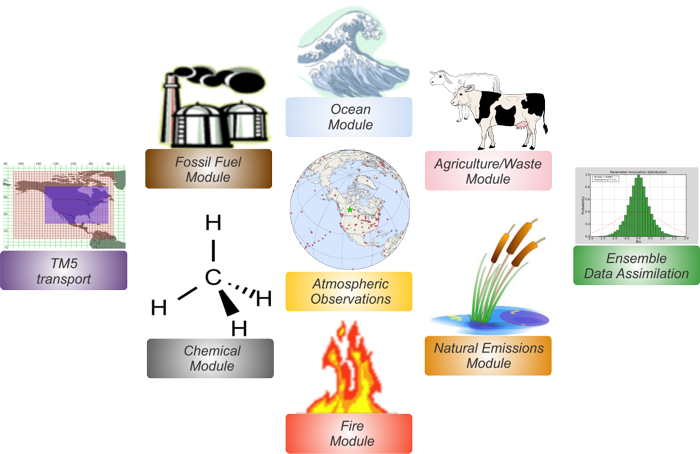The U.S. government is closed. This site will not be updated; however, NOAA websites and social media channels necessary to protect lives and property will be maintained.
To learn more, visit commerce.gov.
For the latest forecasts and critical weather information, visit weather.gov.

To learn more about a CarbonTracker component, click on one of the above images.
Or download the full PDF version for convenience.
Natural Emissions
Introduction
The largest source of methane from natural sources is wetlands. Wetlands are defined as regions that are permanently or seasonally water logged, a broad category that includes both high-latitude peat bogs and typically low-latitude tropical swamps. Saturated soils in warm tropical environments tend to produce the most methane, however, warming Arctic temperatures raise concern that there will be increasing output from high-latitude wetlands and future decomposition of carbon that is currently stored in the frozen soils of the Arctic (e.g. Schaefer et al., 2011).
Methane is easily oxidized in overlying aerobic water columns. Because of this, for a wetland to be most productive, the water table must be at or near the surface and the depth of overlying water must be shallow. Over time, wetland plants have adapted to low oxygen environments by having hollow stems to allow delivery of oxygen and other gases to their root systems. These hollow stems also allow delivery of methane directly to the atmosphere, which along with bubbles, accounts for most of the methane transport into the atmosphere. Diffusion also occurs but is thought to be significantly smaller. Estimates of global emissions from wetlands are about 150-200 TgCH4/yr with most of this occurring in tropical regions. Because emissions are sensitive to temperature and precipitation, they exhibit significant seasonal cycles and inter-annual variability, especially at high latitudes.
Other natural sources of methane include enteric fermentation in insects (mainly termites) and wild ruminants. Both of these sources are thought to be much smaller than that from wetlands (~ 25 TgCH4/yr).
A natural sink of atmospheric methane is oxidation in dry soils (~40 TgCH4/yr). Wetlands that undergo dry and wet seasons can actually switch between being sources and sinks of methane.
Detailed Description
Methane emissions from wetlands are difficult to quantify for two reasons; their global spatial distribution is difficult to accurately specify and there is large variability in conditions that lead to methane production. This version of CarbonTracker-CH4 uses the prior flux estimates of Bergamaschi et al. (2007) which are based on the wetland distribution of Matthews and Fung (1989) and the wetland emission model of Kaplan (1988). The global total of the prior flux estimate is 175 TgCH4/yr and we assume a prior flux uncertainty of 75%.
The soil sink of methane is based on the study of Ridgwell et al. (1999) and the termite and wild animal sources are from Sanderson (1996) and Houweling et al. (1999).
